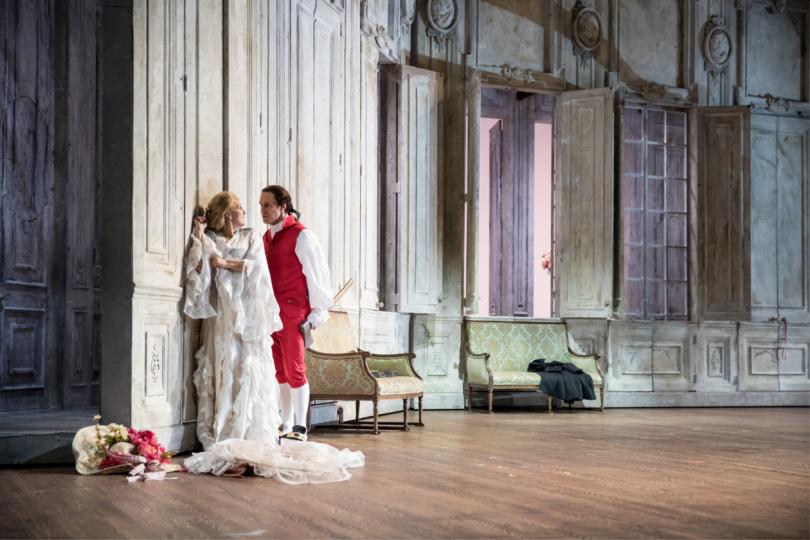How to Handle a Pervert (in 4 acts) –or–:

The Marriage of Figaro. Which one is that?
The one where the guy sings “Figaro! Figaro! Figaro! Figaro! Figaro!”?
No, it’s not that one.
The one where the two men pretend to be Albanians and end up swapping wives?
Nope, not that one either.
The one where the princess has to guess the man’s true name or someone dies?
Not even close.
In a blurb, The Marriage of Figaro is a “…comedy of errors… [which] brings humor, drama, and humanity to this story of class conflict…” but the piece is far too profound and far-reaching to fit inside a blurb. Yes, it is a comedy. The plot is full of disguises, mistaken identities, hiding underneath beds, absurd outdated customs, and self-aware mockery of outdated customs. More than once, the audience of the Ordway was laughing so loud it drowned out the full orchestra and opera chorus. I admit, it is a comedy. I both giggled and snickered.
But it is a comedy in the same way the 1993 classic (and possibly my favorite movie) Groundhog Day is a comedy. It uses humor as the driving force for each scene but uses that driving force to arrive at incredibly profound subject matter. Groundhog Day uses the humor of Bill Murray to have a discussion about the existential void and the (hopeful) persistence of personal meaning. Figaro uses physical comedy and outlandish scenarios to have a discussion about lewd and abusive men and their (hopeful) demise. That’s right, this most perfect opera is a 231-year-old instruction manual on how to bring a pig to justice. Every time you’ve heard the overture in a car commercial or sung a bit of its music in high school voice lessons you were experiencing part of a story on how to stop a pervert. More about that in a few paragraphs…
On Saturday night in St. Paul, The Ordway was buzzing with excitement for opening night of MN Opera’s latest production. The (presumably) sold-out theater faded to black and was immediately greeted with the familiar overture. I point out the fact that it was immediate because this production skipped right over the most pretentious of classical music traditions: applauding the conductor’s entrance. For which I applaud them (not that I have anything against conductors but it seems like a foolish tradition in the Ordway where 95% of the audience can’t see the conductor anyway).
With neither pomp nor circumstance the show began and was immediately captivating with its profound orchestra and stunning scenery. What followed was 3 hours and 13 minutes of profound human expression so please pardon my brevity in trying to describe such a massive endeavor: The staging was beautiful, the costumes were great, the lighting and the intentional shadows were an art form unto themselves, the orchestra (complete with harpsichord) was perfection. All of these separate elements completed their task of presenting the setting for our performers. The performers were some of the best I’ve seen in recent memory. Angela Mortellaro’s Susanna was sincere and intriguing, Jacques Imbrailo’s Count was powerful, Richard Ollarsaba’s Figaro was likable for 3 acts and then intense once his character cut loose in act 4, and Johanni van Oostrum’s Countess gave the kind of performance that can only be found on an operatic stage. Her powerful singing was startling (I think I audibly gasped at her first notes). Her gentle singing defies logic – she presented all the tenderness and subtlety of a bedtime lullaby while balancing the 44 piece orchestra. I had to remind myself she had no electrical amplification at any point. Singing like hers reminds us that we humans are capable of more than we see on a day-to-day basis. And that’s a pretty darn good reason to go to St. Paul on a Saturday night. In short, the music was remarkable. If these singers and this orchestra had presented a concert version of the opera I’d spend the rest of my review talking all about musical things – movements and melodies and mezzo-sopranos and lots of things that are far less important than the real importance of this piece: the story.
The story is amazing. It is bold and (sadly) relevant. It is both focused and well rounded. The title implies that the main event is a wedding but it is not. There is a wedding, and it’s important but (by its very structure) the opera’s main event is bringing a bad man to justice. The more literal title for this work would be ‘How to Catch a Predator’. In every scene we see how Count Almaviva is a terrible person. He uses his wealth and social standing to pressure women into sex by any means available. He uses the standing law of “droit du seigneur” (also known as “prima nocta”) (in which the ruling nobleman has the right to sleep with every bride in his kingdom on her wedding night) when it suits him. He offers bribes, threats, and physical violence when he deems it necessary. There is no doubt the Count is a bad person. Our protagonists spend every waking moment trying to bring him to justice without sabotaging their own lives (since they have no higher authority than the Count to whom they can appeal). Public opinion is controlled by the Count and private communication (in the Count’s compound) is heavily manipulated by him. The powerless have no means by which to seek justice. We all wish it weren’t so, but this is clearly a tale as old as time: Powerful men become sexually abusive to powerless women and essentially hold them hostage in their silence. If you need evidence that this is a relevant topic for examination, please consult any headline of any media outlet for the past month. I don’t know whether MN Opera chose this piece for its relevance or its music but either way, they’re presenting a work that feels very important right now.
My favorite moments of the show were two startlingly personable scenes in which the two female protagonists sang a couple of the best operatic lyrics I’ve ever read. Susanna (the young woman being pursued by the Count) is caught in a web of deceit and (among other convoluted plot points) seems to be leading on the pervert in order to ultimately expose him. She feels disgusting about this interaction but knows it must be done as she sings “All who know what love is, please forgive me for this lie”. Shortly thereafter, the Countess (the spurned wife of the Count) sings “Where are the promises uttered by his deceitful lips?” She, alone in her room, feels abandoned by her lewd husband. We get the impression he wasn’t always that way – that once he was sincere and loving but he traded in his sincerity a long time ago. I won’t spoil the ending for you but I will raise the question that is implicitly raised by Count Almaviva: What does it mean for a predator to be brought to justice? A prison sentence? Public shaming? The loss of wealth or status? A demonstration of their remorse? I don’t think there was a clear consensus on this topic in 1786 and I don’t think there is now. Is it enough that Kevin Spacey is losing out on upcoming movie deals or that Louis CK will be collectively forgotten about or that Donald Trump is being given everything he ever wanted? For the very real crimes of these people, public shaming doesn’t feel sufficient. But the one piece of progress evident between Figaro and 2017 is that it seems victims are now taken seriously in the court of public opinion.
Even if history doesn’t have much to give, The Marriage of Figaro offers a bit of empathy centuries in the making. Hopefully it will be less relevant 200 years from now.




